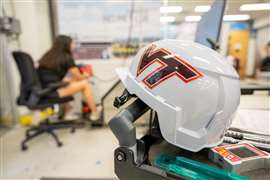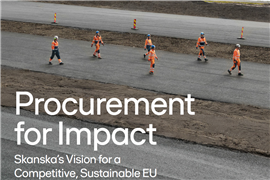Read this article in French German Italian Portuguese Spanish
What are the top-rated hard hats according to Virginia Tech’s new rating system?
26 September 2025
 Virginia Tech Helmet Lab has released what it claims is the first independent ratings system for construction safety helmets. (Image: Lee Friesland for Virginia Tech.)
Virginia Tech Helmet Lab has released what it claims is the first independent ratings system for construction safety helmets. (Image: Lee Friesland for Virginia Tech.)
US university Virginia Tech has launched what it claims is the first rating system for construction safety helmets.
It evaluated and rated a total of 17 helmets in the first round of the new rating system.
Virginia Tech said it has developed the ratings by analysing information from falls in worksite environments. The system draws a “sharp distinction” between traditional hard hats, known as Type I helmets, and Type II helmets that include interior energy-absorbing materials.
The results show that Type II helmets will reduce fall-related concussion risk by 34% on average, and the risk of skull fracture by 65%.
The top-rated helmets show risk reductions of 48% and 77% respectively.
Steve Rowson, director of the Virginia Tech Helmet Lab, which is already known for its work rating other types of head protection like cycling helmets, said, “Our findings show that choosing a Type II helmet can save lives. The difference in protection during a fall is dramatic.”
Rowson, who is also a professor of biomedical engineering, noted that falls cause 60% of the traumatic brain injury fatalties in construction and that existing tests for helmets, set by the American National Standards Institute (ANSI) don’t reflect the force of real-world falls.
He also stressed that it is important for helmets to fit properly and for users to wear the chin strap to keep helmets in place during a fall.
Current hard hat standards only perform impacts at a third of the energy the Helmet Lab does in its test to replicate jobsite falls, Virginia Tech said.
Work to develop tests for construction helmets started in 2024, with a focus on “severe but survivable” jobsite falls. That involved simulating falls from 14ft (4.3m) and 25ft (7.6m) to evaluate concussion and skull fracture risk.
A total of 12 laboratory impacts are performed per helmet, using a new sample for each test. Three impact locations, selected from real-world fall data, are tested at a moderate speed of 5.5 metres per second (m/s) and a high speed of 6.8m/s. The tests measure linear and rotational head accelerations for every impact and correlated to brain and skull injury risk.
The research team then used the lab’s Summation of Tests for the Analysis of Risk (STAR) framework to combine data from multiple tests and compute an overall performance score for nine Type I and seven Type II helmets.
The score the helmets receive is based on weightings that represent the distribution of 100 fall-related head impacts. The STAR score preducts the number of head injuries the worker would sustain if exposed to 100 such impacts. That means that the lower the score a helmet receives, the more likely it is to protect against head injuries. The maximum STAR score is 200 (reflecting the possibility of sustaining both a skull fracture and concussion from a single fall).
Of the 17 helmets Virginia Tech has tested so far, the top five performers were:
1) Milwaukee Tool Bolt with Impact Armour (Type II). Score: 59.21. Rating: *****
2) Milwaukee Tool Bolt (Type II). Score: 66.60. Rating: *****
3) Studson SHK-1 (Type II). Score: 69.27. Rating: *****
4) DeWalt DPG22 (Type II). Score: 70.97. Rating: *****
5) Kask Zenith X2 (Type II). Score: 78.81. Rating: *****
Safety helmets are now the 10th area for which the lab has developed helmet ratings, but it is the first non-sports helmet rating.
Alex Kopp, director of environmental health and safety for the Association of Union Constructors, said, “Virginia Tech brings the research expertise necessary to evaluate helmets from multiple manufacturers objectively. Many contractors are weighing whether to switch helmet styles or brands or whether a switch is needed at all. These independent ratings will give them the data they need to make informed choices that prioritize worker protection.”
Rowson said the programme will continue to update its ratings as new helmets are tested and developed by the industry. Virgina Tech plans to expand the testing to include data on helmet performance when struck by objects soon.
STAY CONNECTED



Receive the information you need when you need it through our world-leading magazines, newsletters and daily briefings.
CONNECT WITH THE TEAM










